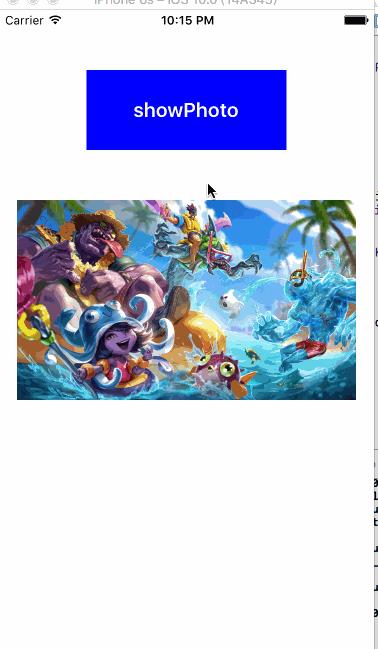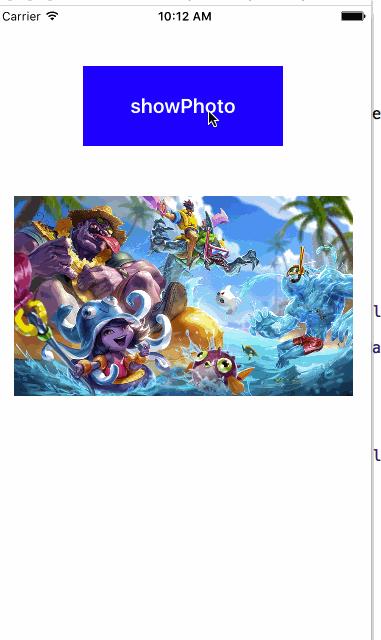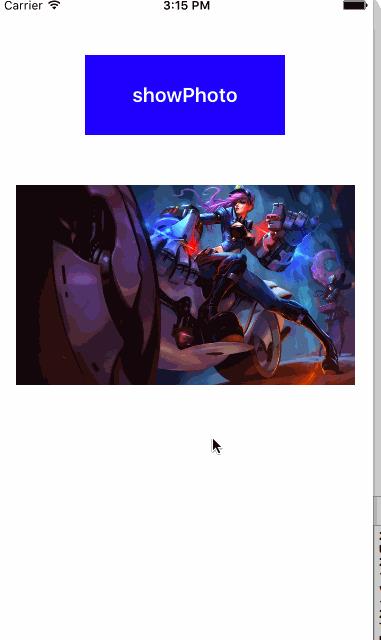iOS卡片式立体轮播仿英雄联盟选择皮肤效果展示
Posted Deft_MKJing宓珂璟
tags:
篇首语:本文由小常识网(cha138.com)小编为大家整理,主要介绍了iOS卡片式立体轮播仿英雄联盟选择皮肤效果展示相关的知识,希望对你有一定的参考价值。
第二次更新:更加丰富的相册图片展示

1.由于不在继承与FlowLayout,只是单纯继承与UIColletionLayout
2.关键方法 layoutAttributesForItemAtIndexPath 在返回的对应index返回需要布局的UICollectionViewLayoutAttributes属性即可
3.还是直接下载代码看自定义的Layout吧,有问题请留言,大过年的写的比较仓促
个人感觉CollectionView过于强大,基本什么界面都能用他来完成需求,只是如果自定义Layout的时候可能性能开销大。如果是普通的需求,他和tableView并没有多大的区别,同样都是通过datasource和delegate两个代理来进行用户交互稍微回顾下CollectionView的构成
1.Cells
2.Supplementary Views 追加视图 (sectionHeader or footer)
3.Decoration Views 装饰视图 (用作背景展示) 这货貌似还没怎么用过
另一方面,对于cell的组织方式和样式,确实由于collectionView比tableView要复杂的多,因此没有按照tableView的方式来定义,而是专门启用了一个布局类UICollectionViewlayout来对collectionView进行布局。废话不多说,系统自带的Layout已经是很常见了,今天写个自定义Layout来做些看起来还是蛮不错的Demo
正常人的Demo





先理论BB以下,不想看的请跳过
实现一个自定义Layout的正常做法就是继承与UICollectionViewlayout,然后重载以下方法,听我一一道来
三个必须手动重载的方法
1.-(CGSize)collectionViewContentSize
返回可见区域内的大小
2.-(NSArray *)layoutAttributesForElementsInRect:(CGRect)rect
返回的是包含UICollectionViewlayoutAttributes对象的数组,该对象可以是cell,supplementary或装饰视图
返回对应indexPath下cell的布局属性
-(UICollectionViewLayoutAttributes _)layoutAttributesForItemAtIndexPath:(NSIndexPath _)indexPath
返回对应indexpath下对应的追加视图属性 (没有可不重载)
-(UICollectionViewLayoutAttributes _)layoutAttributesForSupplementaryViewOfKind:(NSString _)kind atIndexPath:(NSIndexPath *)indexPath
返回对应indexpath下对应的追加视图属性 (没有可不重载)
-(UICollectionViewLayoutAttributes * )layoutAttributesForDecorationViewOfKind:(NSString_)decorationViewKind atIndexPath:(NSIndexPath _)indexPath
3.-(BOOL)shouldInvalidateLayoutForBoundsChange:(CGRect)newBounds
当边界发生变化时,也就是滚动的时候,如果返回Yes,就是会一直调用,而且不断刷新重新计算布局信息一个自动重载的方法
-(void)prepareLayout
一般在该方法中设定一些必要的layout的结构和初始需要的参数等。注意:在需要更新layout时,需要给当前layout发送 -invalidateLayout,该消息会立即返回,并且预约在下一个loop的时候刷新当前layout,这一点和UIView的setNeedsLayout方法十分类似。在-invalidateLayout后的下一个collectionView的刷新loop中,又会从prepareLayout开始,依次再调用-collectionViewContentSize和-layoutAttributesForElementsInRect来生成更新后的布局。



Demo分析
1.简单的做个弹出的动画容器View 以下的self就是指弹出来的View,View上面给了一层underBackView,最终是在改View上面布局
// self是继承于UIView的,给上面的第一个View容器加个动画
- (void)showInSuperView:(UIView *)superView
CAKeyframeAnimation *popAnimation = [CAKeyframeAnimation animationWithKeyPath:@"transform"];
popAnimation.duration = 0.25;
popAnimation.values = @[[NSValue valueWithCATransform3D:CATransform3DMakeScale(0.1f, 0.1f, 1.0f)],
[NSValue valueWithCATransform3D:CATransform3DMakeScale(1.0f, 1.0f, 1.0f)]];
popAnimation.keyTimes = @[@0.2f, @1.0f];
popAnimation.timingFunctions = @[[CAMediaTimingFunction functionWithName:kCAMediaTimingFunctionEaseInEaseOut],
[CAMediaTimingFunction functionWithName:kCAMediaTimingFunctionEaseInEaseOut],
[CAMediaTimingFunction functionWithName:kCAMediaTimingFunctionEaseInEaseOut]];
// 在点击按钮的时候在改方法里面add到父视图上面去
[superView addSubview:self];
// 给View上面的容器View加动画
[self.underBackView.layer addAnimation:popAnimation forKey:nil];
2.简单的懒加载布局视图以及一些回调delegate的设置就没必要多说了,大家都知道
#pragma mark - 懒加载
- (UIView *)underBackView
if (_underBackView == nil)
_underBackView = [[UIView alloc] init];
_underBackView.backgroundColor = [[UIColor blackColor] colorWithAlphaComponent:0.8];
_underBackView.originX = 30;
_underBackView.originY = 60;
_underBackView.width = SCREEN_WIDTH - 2 * _underBackView.originX;
_underBackView.height = SCREEN_HEIGHT - 2 * _underBackView.originY;
_underBackView.layer.cornerRadius = 5;
_underBackView.layer.borderColor = [UIColor redColor].CGColor;
_underBackView.layer.borderWidth = 2.0f;
return _underBackView;
- (UILabel *)nameLabel
if (_nameLabel == nil)
_nameLabel = [[UILabel alloc] init];
_nameLabel.textAlignment = NSTextAlignmentCenter;
_nameLabel.backgroundColor = [UIColor whiteColor];
_nameLabel.font = [UIFont boldSystemFontOfSize:20];
_nameLabel.textColor = [UIColor blueColor];
_nameLabel.layer.cornerRadius = 5.0f;
_nameLabel.layer.borderColor = [UIColor blackColor].CGColor;
_nameLabel.layer.borderWidth = 2.0f;
return _nameLabel;
- (UIButton *)selectedButton
if (_selectedButton == nil)
_selectedButton = [UIButton buttonWithType:UIButtonTypeCustom];
_selectedButton.backgroundColor = [UIColor blackColor];
[_selectedButton setTitle:@"选这个" forState:UIControlStateNormal];
[_selectedButton setTitleColor:[UIColor whiteColor] forState:UIControlStateNormal];
[_selectedButton addTarget:self action:@selector(chooseDone:) forControlEvents:UIControlEventTouchUpInside];
_selectedButton.layer.cornerRadius = 20.0f;
_selectedButton.layer.borderWidth = 2.0f;
_selectedButton.layer.borderColor = [UIColor whiteColor].CGColor;
return _selectedButton;
- (void)chooseDone:(UIButton *)button
if (self.delegate && [self.delegate respondsToSelector:@selector(selectedHero:)])
[self.delegate selectedHero:self.dataSource[_selectedIndex]];
- (UIButton *)closeButton
if (_closeButton == nil)
_closeButton = [UIButton buttonWithType:UIButtonTypeCustom];
_closeButton.backgroundColor = [UIColor redColor];
[_closeButton setImage:[UIImage imageNamed:@"close"] forState:UIControlStateNormal];
[_closeButton addTarget:self action:@selector(close:) forControlEvents:UIControlEventTouchUpInside];
return _closeButton;
- (void)close:(UIButton *)button
if (self.delegate && [self.delegate respondsToSelector:@selector(closePopView)])
[self.delegate closePopView];
- (UICollectionView *)collectionView
if (_collectionView == nil)
MKJCollectionViewFlowLayout *flow = [[MKJCollectionViewFlowLayout alloc] init];
flow.scrollDirection = UICollectionViewScrollDirectionHorizontal;
flow.itemSize = CGSizeMake(self.underBackView.width / 2, self.underBackView.width - 100);
flow.minimumLineSpacing = 30;
flow.minimumInteritemSpacing = 30;
flow.needAlpha = YES;
flow.delegate = self;
CGFloat oneX =self.underBackView.width / 4;
flow.sectionInset = UIEdgeInsetsMake(0, oneX, 0, oneX);
_collectionView = [[UICollectionView alloc] initWithFrame:CGRectMake(0, 30, self.underBackView.bounds.size.width, self.underBackView.bounds.size.height * 0.65) collectionViewLayout:flow];
_collectionView.backgroundColor = [UIColor whiteColor];
_collectionView.delegate = self;
_collectionView.dataSource = self;
_collectionView.showsHorizontalScrollIndicator = NO;
[_collectionView registerNib:[UINib nibWithNibName:indentify bundle:nil] forCellWithReuseIdentifier:indentify];
return _collectionView;
3.关键是还是要看最终自定义的FlowLayout一些小东西的实现
重载的方法和方式在上面都已经理论了一番了,需要的自己去上面看看
第一个效果:需要一个放大的效果和透明的效果 
// 重载第一个方法
// 返回可见区域的的内容尺寸
- (CGSize)collectionViewContentSize
return [super collectionViewContentSize];
// 重载方法第二个
// 返回rect中所有元素的布局属性
// 返回的是包含UICollectionViewLayoutAttributes的NSArray
// UICollectionViewAttributes可以是cell,追加视图以及装饰视图的信息,通过以下三个不同的方法可以获取到不同类型的UICollectionViewLayoutAttributes属性
// layoutAttributesForCellWithIndexPath: 返回对应cell的UICollectionViewAttributes布局属性
// layoutAtttibutesForSupplementaryViewOfKind:withIndexPath: 返回装饰的布局属性 如果没有追加视图可不重载
// layoutAttributesForDecorationViewOfKind:withIndexPath: 返回装饰的布局属性 如果没有可以不重载
- (NSArray<UICollectionViewLayoutAttributes *> *)layoutAttributesForElementsInRect:(CGRect)rect
//1. 获取可见区域
CGRect visibleRect = CGRectMake(self.collectionView.contentOffset.x, 0, self.collectionView.bounds.size.width, self.collectionView.bounds.size.height);
//2. 获得这个区域的item
NSArray *visibleItemArray = [super layoutAttributesForElementsInRect:visibleRect];
//3. 遍历,让靠近中心线的item方法,离开的缩小
for (UICollectionViewLayoutAttributes *attributes in visibleItemArray)
//1. 获取每个item距离可见区域左侧边框的距离 有正负
CGFloat leftMargin = attributes.center.x - self.collectionView.contentOffset.x;
//2. 获取边框距离屏幕中心的距离(固定的)
CGFloat halfCenterX = self.collectionView.frame.size.width / 2;
//3. 获取距离中心的的偏移量,需要绝对值
CGFloat absOffset = fabs(halfCenterX - leftMargin);
//4. 获取的实际的缩放比例 距离中心越多,这个值就越小,也就是item的scale越小 中心是方法最大的
CGFloat scale = 1 - absOffset / halfCenterX;
//5. 缩放
attributes.transform3D = CATransform3DMakeScale(1 + scale * MKJMinZoomScale, 1 + scale * MKJMinZoomScale, 1);
// 是否需要透明
if (self.needAlpha)
if (scale < 0.6)
attributes.alpha = 0.6;
else if (scale > 0.99)
attributes.alpha = 1.0;
else
attributes.alpha = scale;
NSArray *attributesArr = [[NSArray alloc] initWithArray:visibleItemArray copyItems:YES];
return attributesArr;
第二个效果:如何让滚动的的item根据中心距离,自动居中对齐,避免滚动到哪停到哪
这里做了第一个和最后一个的判断,不然在头和尾会出现对不齐的情况
// 重载第四个属性,item自动中心对齐
// 该方法可写可不写,主要是让滚动的item根据距离中心的值,确定哪个必须展示在中心,不会像普通的那样滚动到哪里就停到哪里
- (CGPoint)targetContentOffsetForProposedContentOffset:(CGPoint)proposedContentOffset withScrollingVelocity:(CGPoint)velocity
// ProposeContentOffset是本来应该停下的位子
// 1. 先给一个字段存储最小的偏移量 那么默认就是无限大
CGFloat minOffset = CGFLOAT_MAX;
// 2. 获取到可见区域的centerX
CGFloat horizontalCenter = proposedContentOffset.x + self.collectionView.bounds.size.width / 2;
// 3. 拿到可见区域的rect
CGRect visibleRec = CGRectMake(proposedContentOffset.x, 0, self.collectionView.bounds.size.width, self.collectionView.bounds.size.height);
// 4. 获取到所有可见区域内的item数组
NSArray *visibleAttributes = [super layoutAttributesForElementsInRect:visibleRec];
// 遍历数组,找到距离中心最近偏移量是多少
for (UICollectionViewLayoutAttributes *atts in visibleAttributes)
// 可见区域内每个item对应的中心X坐标
CGFloat itemCenterX = atts.center.x;
// 比较是否有更小的,有的话赋值给minOffset
if (fabs(itemCenterX - horizontalCenter) <= fabs(minOffset))
minOffset = itemCenterX - horizontalCenter;
// 这里需要注意的是 上面获取到的minOffset有可能是负数,那么代表左边的item还没到中心,如果确定这种情况下左边的item是距离最近的,那么需要左边的item居中,意思就是collectionView的偏移量需要比原本更小才是,例如原先是1000的偏移,但是需要展示前一个item,所以需要1000减去某个偏移量,因此不需要更改偏移的正负
// 但是当propose小于0的时候或者大于contentSize(除掉左侧和右侧偏移以及单个cell宽度) 、
// 防止当第一个或者最后一个的时候不会有居中(偏移量超过了本身的宽度),直接卡在推荐的停留位置
CGFloat centerOffsetX = proposedContentOffset.x + minOffset;
if (centerOffsetX < 0)
centerOffsetX = 0;
if (centerOffsetX > self.collectionView.contentSize.width -(self.sectionInset.left + self.sectionInset.right + self.itemSize.width))
centerOffsetX = floor(centerOffsetX);
return CGPointMake(centerOffsetX, proposedContentOffset.y);
第三个效果:如何让视图滚动的时候(不触发点击事件),自动把滚动到第几个的图片展示出来(delegate)
CGPoint pInView = [self.collectionView.superviewconvertPoint:self.collectionView.centertoView:self.collectionView];// 重载第三个属性
// 滚动的时候会一直调用
// 当边界发生变化的时候,是否应该刷新布局。如果YES那么就是边界发生变化的时候,重新计算布局信息 这里的newBounds变化的只有x值的变化,也就是偏移量的变化
- (BOOL)shouldInvalidateLayoutForBoundsChange:(CGRect)newBounds
// 把collectionView的父视图(underBackView)上的中心坐标,转换到整个CollectionView ContentSize中的坐标 根据point来计算对应的indexpath
CGPoint pInView = [self.collectionView.superview convertPoint:self.collectionView.center toView:self.collectionView];
// 通过坐标获取对应的indexpath
NSIndexPath *indexPathNow = [self.collectionView indexPathForItemAtPoint:pInView];
if (indexPathNow.row == 0)
if (newBounds.origin.x < SCREEN_WIDTH / 2)
if (_index != indexPathNow.row)
_index = 0;
if (self.delegate && [self.delegate respondsToSelector:@selector(collectioViewScrollToIndex:)])
[self.delegate collectioViewScrollToIndex:_index];
else
if (_index != indexPathNow.row)
_index = indexPathNow.row;
if (self.delegate && [self.delegate respondsToSelector:@selector(collectioViewScrollToIndex:)])
[self.delegate collectioViewScrollToIndex:_index];
[super shouldInvalidateLayoutForBoundsChange:newBounds];
return YES;
第四个效果:点击Item,自动中心对齐
// 点击item的时候
- (void)collectionView:(UICollectionView *)collectionView didSelectItemAtIndexPath:(NSIndexPath *)indexPath
// 这里的坐标相互转换 可看我写的另一个小博客
CGPoint pInUnderView = [self.underBackView convertPoint:collectionView.center toView:collectionView];
// 获取中间的indexpath
NSIndexPath *indexpathNew = [collectionView indexPathForItemAtPoint:pInUnderView];
if (indexPath.row == indexpathNew.row)
NSLog(@"点击了同一个");
return;
else
// 点击不同就把点击的滚动到中心居中
[self.collectionView scrollToItemAtIndexPath:indexPath atScrollPosition:UICollectionViewScrollPositionCenteredHorizontally animated:YES];


Demo地址:点击打开链接
Demo写的很仓促,有些细节还没做的很好,只是玩英雄联盟选择皮肤的时候突然想到要写一个试试,各位有什么问题可以留言,我会慢慢更正能阅读完博主的文章也是不容易,谢谢捧场,好人一生平安,博主会不断进步的,谢谢






以上是关于iOS卡片式立体轮播仿英雄联盟选择皮肤效果展示的主要内容,如果未能解决你的问题,请参考以下文章